For this part, you are allowed 30 minutes to write a news report to your campus newspaper on a visit to a Hope Elementary School organized by your Student Union. You should write at least 120 words but no more than 180 words.
正确答案及解析
正确答案
A two-day visit to Fanhai Hope Elementary School organized by the Student Union of our university has been completed as scheduled this weekend.
Aiming at fostering college students' service awareness and helping pupils of rural areas better understand the colorful college life so as to motivate them to study harder, the Student Union organized an activity named A Trip of Love Seed. A team of 30 college students' participated in this trip. The visit was warmly welcomed by all the students and staff of Fanhai, followed by a range of colorful activities, such as the interaction among students about the fascinating college life, a visit to the school art show of students' works of painting and handicraft and teaching activities focusing on showing the magical science world to the pupils.
Both the pupils and our college students were actively involved in all these brilliant activities. And the headmaster of Fanhai spoke highly of this trip as well as the devotion, enthusiasm and creativity of our students.
解析
我校学生会组织的范海希望小学为期两天的访问已于本周末如期完成。
为了培养大学生的服务意识,帮助农村学生更好地了解丰富多彩的大学生活,激励他们更加努力地学习,学生会组织了“爱心种子之旅”活动。一个由30名大学生组成的团队参加了这次旅行。参观活动受到了泛海全体师生的热烈欢迎,随后还开展了一系列丰富多彩的活动,如同学们相互交流精彩的大学生活,参观学校学生绘画作品和手工艺品艺术展,以及向学生展示神奇科学世界的教学活动。
学生们和我们的大学生都积极参加了所有这些精彩的活动。范海校长高度评价了这次旅行,以及我们学生的奉献精神、热情和创造力。
你可能感兴趣的试题
Textbooks represent an 11 billion dollar industry, up from $8 billion in 2014. Textbook publisher Pearson is the largest publisher -- of any kind -- in the world.
It costs about $1 million to create a new textbook. A freshman textbook will have dozens of contributors, from subject-matter experts through graphic and layout artists to expert reviewers and classroom testers. Textbook publishers connect professors, instructors and students in ways that alternatives, such as open e-textbooks and open educational resources, simply do not. This connection happens not only by means of collaborative development, review and testing, but also at conferences where faculty regularly decide on their textbooks and curricula for the coming year.
It is true that textbook publishers have recently reported losses, largely due to students renting or buying used print textbooks. But this can be chalked up to the excessively high cost of their books -- which has increased over 1,000 percent since 1977. A restructuring of the textbook industry may well be in order. But this does not mean the end of the textbook itself.
While they may not be as dynamic as an iPad, textbooks are not passive or lifeless. For example, over the centuries, they have simulated (模拟) dialogues in a number of ways. From 1800 to the present day, textbooks have done this by posing questions for students to answer inductively (归纳性地). That means students are asked to use their individual experience to come up with answers to general questions. Today's psychology texts, for example, ask: "How much of your personality do you think you inherited?" while ones in physics say: "How can you predict where the ball you tossed will land?"
Experts observe that "textbooks come in layers, something like an onion." For an active learner, engaging with a textbook can be an interactive experience. Readers proceed at their own pace. They "customize" their books by engaging with different layers and linkages. Highlighting, Post-It notes, dog-ears and other techniques allow for further customization that students value in print books over digital forms of books.
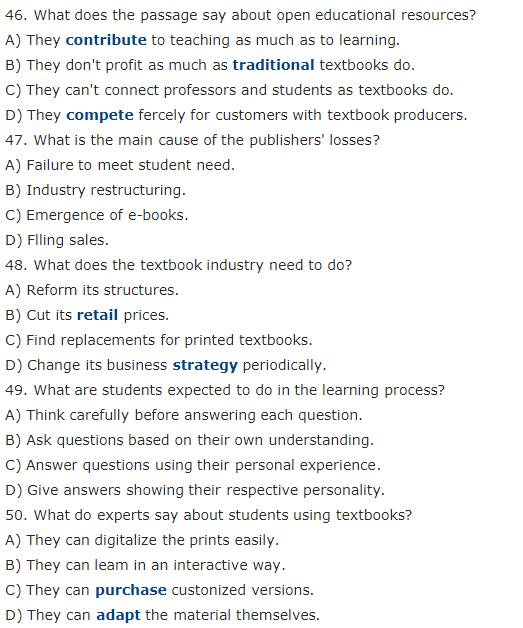
- 查看答案
When we think of animals and plants, we have a pretty good way of dividing them into two distinct groups: one converts sunlight into energy and the other has to eat food to make its energy. Well, those dividing lines come crashing down with the discovery of a sea slug (海蛞蝓) that's truly half animal and half plant. It's pretty incredible how it has managed to hijack the genes of the algae (藻类) on which it feeds.
The slugs can manufacture chlorophyll, the green pigment (色素) in plants that captures energy from sunlight, and hold these genes within their body. The term kleptoplasty is used to describe the practice of using hijacked genes to create nutrients from sunlight. And so far, this green sea slug is the only known animal that can be truly considered solar-powered, although some animals do exhibit some plant-like behaviors. Many scientists have studied the green sea slugs to confirm that they are actually able to create energy from sunlight.
In fact, the slugs use the genetic material so well that they pass it on to their future generations. Their babies retain the ability to produce their own chlorophyll, though they can't generate energy from sunlight until they've eaten enough algae to steal the necessary genes, which they can't yet produce on their own.
"There's no way on earth that genes from an alga should work inside an animal cell," says Sidney Pierce from the University of South Florida. "And yet here, they do. They allow the animal to rely on sunshine for its nutrition. So if something happens to their food source, they have a way of not starving to death until they find more algae to eat."
The sea slugs are so good at gathering energy from the sun that they can live up to nine months without having to eat any food. They get all their nutritional needs met by the genes that they've hijacked from the algae.
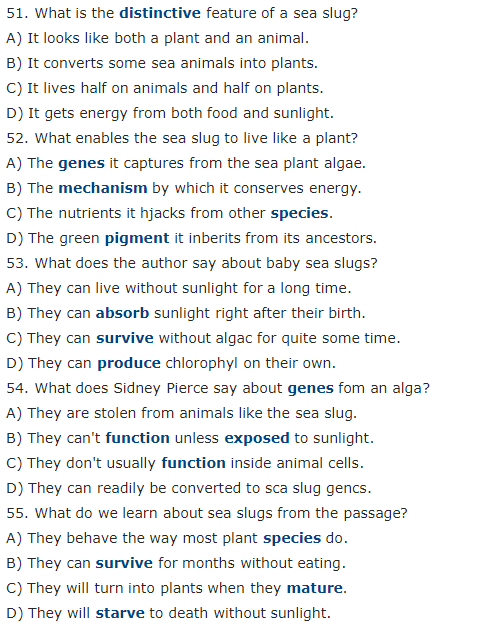
- 查看答案
For this part, you are allowed 30 minutes to write a letter to a foreign friend who wants to teach English in China. Please recommend a city to him. You should write at least 120 words but no more than 180 words.
- 查看答案
A) We've always been a hands-on, do it-yourself kind of nation. Ben Franklin, one of America's founding fathers, didn't just invent the lightning rod. His creations include glasses, innovative stoves and more.
B) Franklin, who was largely self-taught, may have been a genius, but he wasn't really an exception when it comes to American making and creativity.
C) The personal computing revolution and philosophy of disruptive innovation of Silicon Valley grew, in part, out of the creations of the Homebrew Computer Club, which was founded in a garage in Menlo Park, California, in the mid-1970s. Members-including guys named Jobs and Wozniak-started making and inventing things they couldn't buy.
D) So it's no surprise that the Maker Movement today is thriving in communities and some schools across America. Making is available to ordinary people who aren't tied to big companies, big defense labs or research universities. The maker philosophy echoes old ideas advocated by John Dewey, Montessori, and even ancient Greek philosophers, as we pointed out recently.
E) These maker spaces are often outside of classrooms, and are serving an important educational function. The Maker Movement is rediscovering learning by doing, which is Dewey's phrase from 100 years ago. We are rediscovering Dewey and Montessori and a lot of the practices that they pioneered that have been forgotten or at least put aside. A maker space is a place which can be in a school, but it doesn't look like a classroom. It can be in a library. It can be out in the community. It has tools and materials. It's a place where you get to make things based on your interest and on what you, re learning to do.
F) Ideas about learning by doing have struggled to become mainstream educationally, despite being old concepts from Dewey and Montessori, Plato and Aristotle, and in the American context, Ralph Emerson, on the value of experience and self-reliance. It's not necessarily an efficient way to learn. We learn, in a sense, by trial and error. Learning from experience is something that takes time and patience. It's very individualized. If your goal is to have standardized approaches to learning, where everybody learns the same thing at the same time in the same way, then learning by doing doesn't really fit that mold anymore. It's not the world of textbooks. It's not the world of testing.
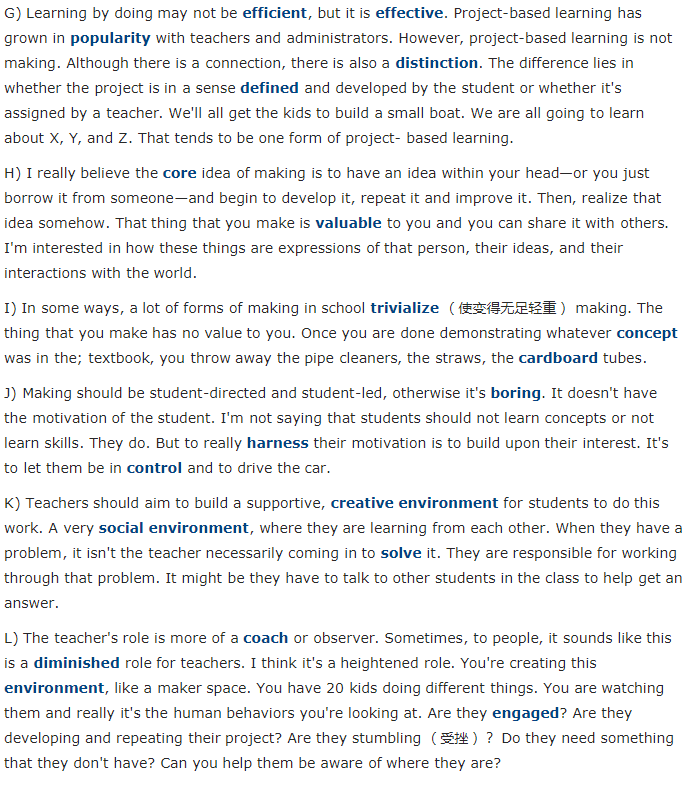
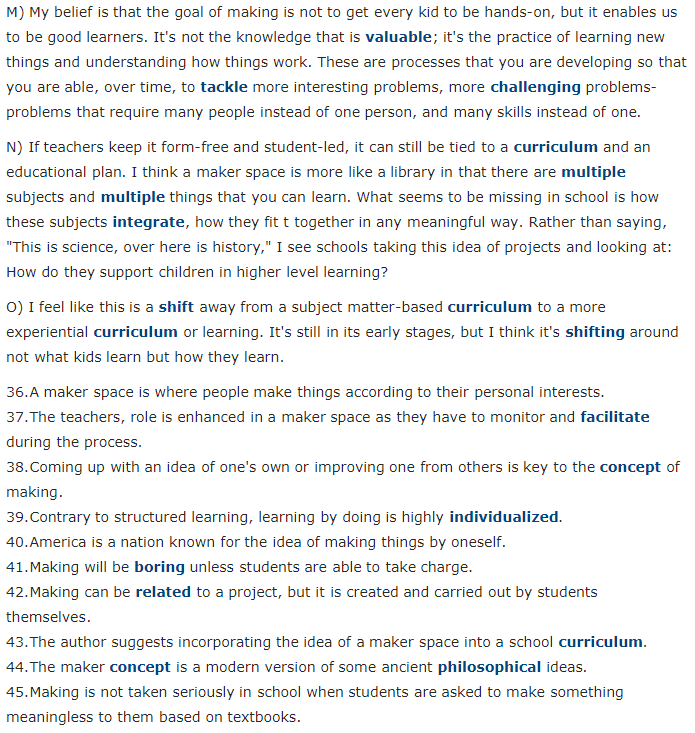
- 查看答案
Professor Ashok Goel of Georgia Tech developed an artificially intelligent teaching assistant to help handle the enormous number of student questions in the online class, Knowledge-Based Artificial Intelligence. This online course is a core requirement of Georgia Tech's online Master of Science in Computer Science program. Professor Goel already had eight teaching assistants, but that wasn't enough to deal with the overwhelming number of daily questions from students.
Many students drop out of online courses because of the lack of teaching support. When students feel isolated or confused and reach out with questions that go unanswered, their motivation to continue begins to fade. Professor Goel decided to do something to remedy this situation and his solution was to create a virtual assistant named Jill Watson, which is based on the IBM Watson platform.
Goel and his team developed several versions of Jill Watson before releasing her to the online forums. At first, the virtual assistant wasn't too great. But Goel and his team sourced the online discussion forum to find all the 40,000 questions that had ever been asked since the class was launched. Then they began to feed Jill with the questions and answers. After some adjustments and sufficient time, Jill was able to answer the students' questions correctly 97% of the time. The virtual assistant became so advanced and realistic that the students didn't know she was a computer. The students, who were studying artificial intelligence, were interacting with the virtual assistant and couldn't tell it apart from a real human being. Goel didn't inform them about Jill's true identity until April 26. The students were actually very positive about the experience.
The goal of Professor Goel's virtual assistant next year is to take over answering 40% of all the questions posed by students on the online forum. The name Jill Watson will, of course, change to something else next semester. Professor Goel has a much rosier outlook on the future of artificial intelligence than, say, Elon Musk, Stephen Hawking, Bill Gates or Steve Wozniak.
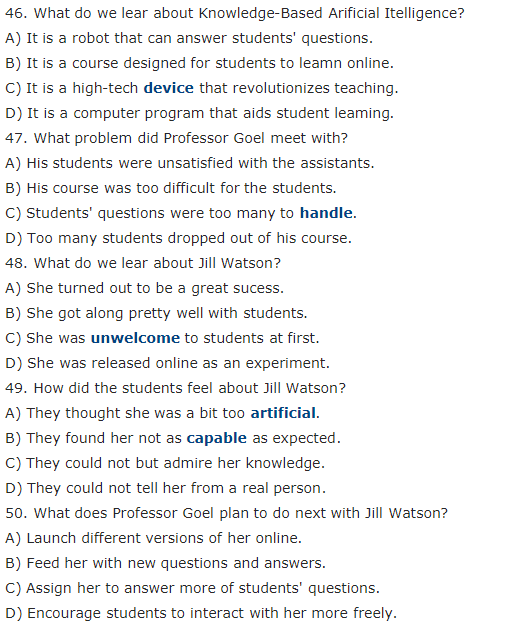
- 查看答案